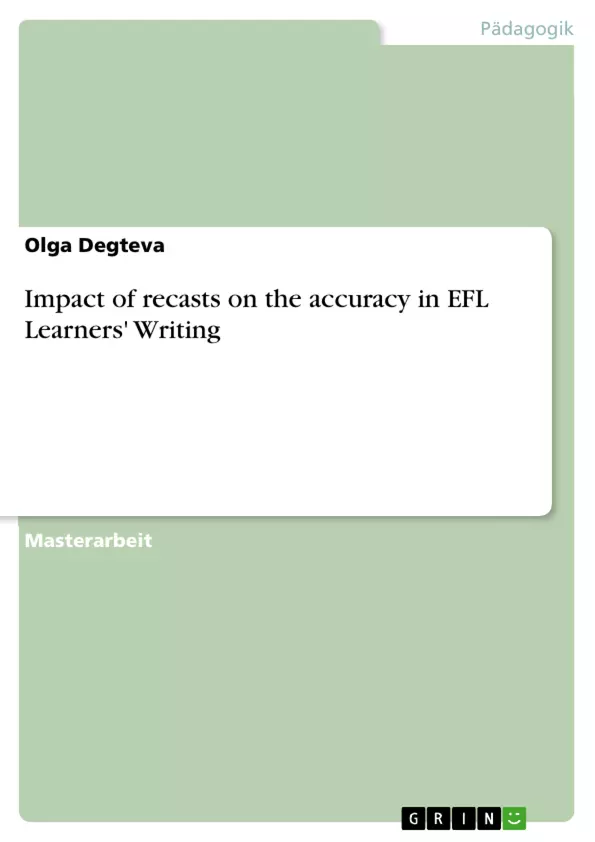Since the famous Truscott’s “The case against grammar correction in L2 writing class” (1996) there has been an ongoing debate in SLA research about the value of corrective feedback and its different forms. A growing number of empirical research is now investigating the question, and although more and more evidence is obtained against Truscott’s statement, there are still no definite conclusions about whether the feedback should be given, and if yes, in what form.
The present study, designed as a longitudinal single-subject study with two participants, contributes to this research base, investigating one particular form of written corrective feedback – focused recast. During seven weeks thirteen written texts of each participant (first three served as a pre-test, the last one as a post-test) were given feedback in the form of focused recasts and then analysed for errors. All types of errors were targeted in the study. Also item-based and rule-based errors were considered separately to find out whether Ferris’s (2002) assumption about treatable and untreatable errors could be confirmed.
The results showed significant decrease in the number of errors immediately after the baseline, and then steady downtrend throughout the treatment phase up to the post-test. The comparison of the pre-test and post-test scores let to conclude that recasts significantly assisted in increasing accuracy of writing. Quantitative analysis showed that the number of rule-based errors decreased more than the number of item-based errors.
Qualitative analysis of the data of one of the participants showed, that item-based errors were treatable. It also brought up the suggestion that item-based features cannot be treated as a group. Each item is a single phenomenon which is not a part of any grammatical system of the language, and unlike rule-based features, no generalization can be applied to item-based features. The study showed that if to take item-based errors as single phenomenon, then both rule-based errors and item-based errors are equally treatable, thus questioning the ground for classifying errors as treatable and untreatable.
The study also suggests a direction of the further research on the effect of recasts on the complex feature systems, such as Conditional III or Modal Verbs for expressing possibility in the past. These features failed to be corrected through recasts, but due to their complexity a longer study is needed to investigate the possibilities of recasts.
Inhaltsverzeichnis
- CHAPTER 1 INTRODUCTION
- 1.1.Background of the problem
- 1.2. Purpose of the study
- 1.3. Problem Statement and Research Question
- 1.4. Significance of the study
- 1.5. Limitations and Delimitations of the Study
- CHAPTER 2 LITERATURE REVIEW
- 2.1. Present State of Affairs in the Research on Written Feedback in SLA
- 2.2. Direct vs. Indirect Feedback
- 2.3. Focused vs. Unfocused Feedback
- 2.4. Research on Recasts and Reformulations
- CHAPTER 3 METHOD
- 3.1. Research Design
- 3.2. Operationalisation
- 3.3. Participants
- 3.4. Tasks, treatment and procedures
- 3.4.1. Baseline
- 3.4.2. Treatment phase
- 3.4.3. Post-test
- 3.4.4. Questionnaire for research question N 3
- 3.5. Data Analysis
- 3.5.1.Scoring
- 3.5.2. Statistical Procedures
- 3.5.3. Pre-test and Post-test Scores
- 3.5.4. Qualitative Analysis
- CHAPTER 4. RESULTS AND DISCUSSION
- 4.1. Do Focused Recasts Encourage Learners to Attend to Form and Increase Accuracy?
- 4.2. Are Some Types of Errors More Affected by Focused Recasts Than Others?
- 4.3. How Do Learners Perceive Focused Recasts? What Is Their Attitude to Such Kind of Feedback?
Zielsetzung und Themenschwerpunkte
Die vorliegende Forschungsarbeit untersucht den Einfluss gezielter Rückmeldungen in Form von „Recasts“ auf die Schreibgenauigkeit von Englisch als Fremdsprache (EFL)-Lernenden. Das Ziel der Studie ist es, die Wirksamkeit dieser Art von Feedback zu analysieren und zu beurteilen, ob es zu einer Verbesserung der Grammatikgenauigkeit bei EFL-Schreibenden führt. Die Studie untersucht auch, ob bestimmte Fehlertypen durch gezielte Rückmeldungen stärker beeinflusst werden als andere.
- Der Einfluss von gezielten Rückmeldungen in Form von „Recasts“ auf die Schreibgenauigkeit von EFL-Lernenden
- Die Wirksamkeit verschiedener Feedback-Formen im EFL-Unterricht
- Die Unterscheidung zwischen item-basierten und regelbasierten Fehlern in der EFL-Schreibentwicklung
- Die Analyse der Wahrnehmung und Einstellung von EFL-Lernenden gegenüber gezielten Rückmeldungen
- Die Entwicklung von Erkenntnissen für den EFL-Unterricht und die Förderung der Schreibkompetenz
Zusammenfassung der Kapitel
Kapitel 1 führt in das Thema der Studie ein und präsentiert den Forschungsstand zur Wirksamkeit von Rückmeldungen im EFL-Schreiben. Es werden die Forschungsfrage, die Zielsetzung und die Relevanz der Studie erläutert. Kapitel 2 bietet einen umfassenden Literaturüberblick zu den aktuellen Forschungsbefunden im Bereich der schriftlichen Rückmeldung im Fremdsprachenlernen. Es werden verschiedene Formen der Rückmeldung und ihre jeweiligen Auswirkungen auf die Lernerentwicklung diskutiert. Kapitel 3 beschreibt das Forschungsdesign, die Operationalisierung, die Teilnehmenden und die angewandten Verfahren. Die Studie beinhaltet eine longitudinale Einzelpersonenstudie mit zwei Teilnehmern. Die Teilnehmenden erhielten über einen Zeitraum von sieben Wochen in ihren schriftlichen Texten gezielte „Recasts“ als Feedback. Die Datenanalyse umfasst sowohl quantitative als auch qualitative Methoden. Kapitel 4 präsentiert die Ergebnisse der Studie und analysiert den Einfluss von gezielten „Recasts“ auf die Schreibgenauigkeit der Teilnehmenden. Es werden Unterschiede in der Wirkung von Rückmeldungen auf verschiedene Fehlertypen untersucht.
Schlüsselwörter
EFL-Schreiben, Korrektives Feedback, „Recasts“, item-basierte Fehler, regelbasierte Fehler, Fehlerkorrektur, Schreibgenauigkeit, Sprachentwicklung.
- Quote paper
- Olga Degteva (Author), 2011, Impact of recasts on the accuracy in EFL Learners' Writing, Munich, GRIN Verlag, https://www.grin.com/document/174851



